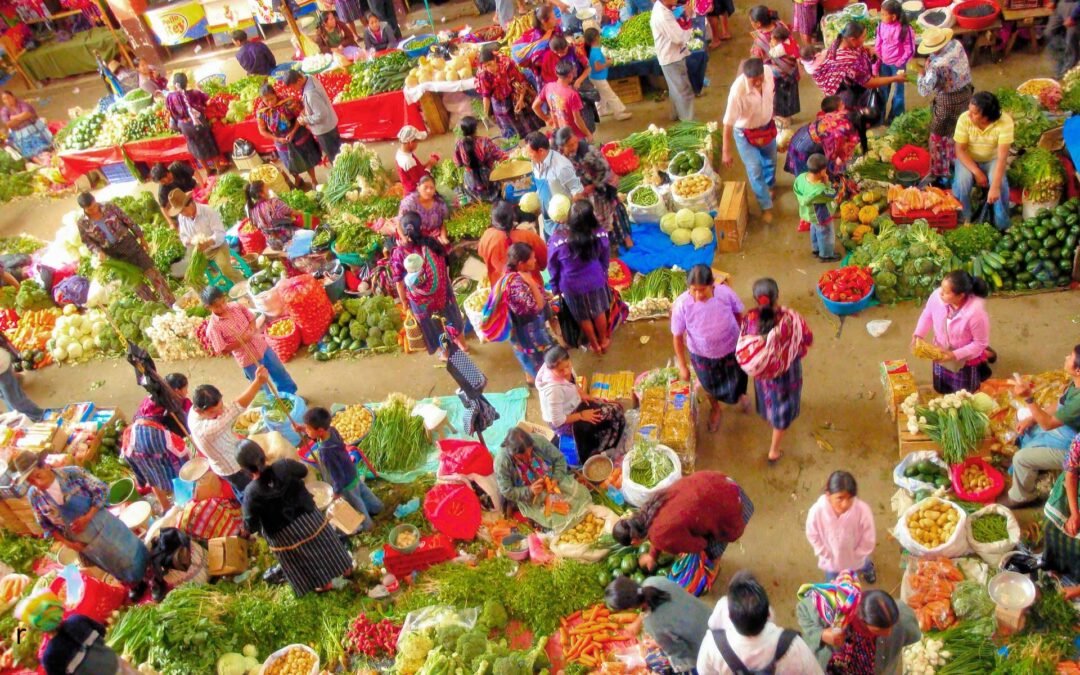Exploring the Vibrant Flavors of Guatemalan Cuisine
Exploring the vibrant flavors of Guatemalan cuisine reveals a rich fusion of Mayan roots, Spanish influence, and unique local ingredients across every dish.
A Culinary Adventure Like No Other
Welcome to a culinary adventure like no other! In this article, we invite you to join us on a journey to explore the unique and vibrant flavors of Guatemalan cuisine. From the rich and aromatic spices to the exotic tropical fruits and the hearty street food, Guatemala offers a gastronomic experience that is truly one-of-a-kind and will leave your taste buds craving for more.
Immerse yourself in a world where ancient Mayan traditions and Spanish influences blend harmoniously, giving birth to a unique and diverse culinary heritage. Uncover the secrets behind iconic Guatemalan dishes such as Pepián, a savory meat stew, and Kak’ik, a spicy turkey soup with a hint of chocolate. Experience the mouthwatering flavors of traditional street food like tostadas, tamales, and empanadas while savoring freshly brewed local coffee or indulging in a refreshing horchata.
Whether you’re a food enthusiast looking for new flavors or a traveler seeking an authentic cultural experience, Guatemalan cuisine has something for everyone. Let’s dive into its rich history, bold flavors, and vibrant culinary traditions.

Historical Influences on Guatemalan Cuisine
Mayan Roots and Indigenous Heritage
Guatemalan cuisine is a melting pot of flavors and influences from various cultures that have shaped the country’s culinary traditions. The country’s history is deeply intertwined with the ancient Maya civilization, greatly influencing local cuisine. The Mayans valued corn as their staple crop, which remains a fundamental ingredient in Guatemalan dishes.

Spanish Colonization and Culinary Integration
When the Spanish arrived in Guatemala in the 16th century, they brought new ingredients and cooking techniques that merged with Mayan traditions. Spanish influences can be seen in tomatoes, onions, and garlic, and the introduction of dishes like tamales and chiles rellenos.
Global Influences
Guatemalan cuisine also incorporates flavors from African, Caribbean, and Middle Eastern cuisines:
-
African influence: Cooking techniques and ingredients brought by enslaved Africans.
-
Caribbean & Middle Eastern flavors: Seen in spices like cinnamon, cloves, and allspice.

Staple Ingredients in Guatemalan Dishes
Guatemalan cuisine relies on a variety of staple ingredients that form the foundation of many traditional dishes.
- Corn (maize) – Used in tortillas, tamales, and atoles (a thick, hot drink).
- Beans – Black and red beans are essential, used in dishes like frijoles volteados and bean stews.
- Rice – Commonly served with meat or poultry dishes.
- Vegetables – Tomatoes, onions, garlic, bell peppers.
- Herbs & Spices – Cilantro, oregano, cumin.
Traditional Guatemalan Dishes and Their Recipes
Guatemala boasts many traditional dishes, each with unique flavors and preparations. Here are some of the most iconic:
Pepián
A hearty stew and one of Guatemala’s most beloved dishes. Made with a blend of spices including annatto seeds, cumin, and cloves, often prepared with chicken or beef and served with rice and tortillas.
Kak’ik
A traditional Mayan dish — spicy turkey soup with roasted peppers, tomatoes, onions, achiote, and coriander. A small piece of chocolate is added for subtle richness. Often served with rice and tortillas.
Rellenitos de Plátano
Sweet and savory treats made by mashing ripe plantains, filling them with sweetened black bean paste, then frying them. Dusted with sugar and cinnamon.

Regional Variations in Guatemalan Cuisine
Guatemala’s diverse geography gives rise to distinct regional flavors:
Highlands
Heavily influenced by Mayan traditions. Key ingredients:
-
Corn, beans, chilies
-
Dishes like Kaq Ik and Tamalitos de Elote (sweet corn tamales)
Coastal Regions
Seafood plays a prominent role:
-
Dishes like Tapado (seafood soup with coconut milk)
-
Ceviche with marinated raw fish or shrimp
Eastern Guatemala
Caribbean influences shine here:
-
Use of coconut and tropical fruits
-
Popular dishes: Tamago, Rice and Beans

Street Food and Snacks in Guatemala
Guatemalan street food is a feast for the senses, offering a wide variety of flavors and textures:
Tostadas
Crispy tortillas topped with shredded chicken, lettuce, tomatoes, avocado, and a tangy tomato sauce.
Tamales
Steamed corn dough parcels filled with chicken, pork, or vegetables, wrapped in banana leaves. A popular breakfast or lunch, best paired with Guatemalan coffee.
Empanadas
Savory pastries filled with meat, cheese, or vegetables — ideal for a quick and tasty snack.
Popular Beverages in Guatemalan Cuisine
Guatemala is known for its rich and flavorful beverages:
Horchata
A rice-based drink flavored with cinnamon, vanilla, and sometimes nutmeg. Served cold over ice.
Atol de Elote
A thick, creamy corn-based drink made from fresh corn, milk, sugar, and spices. Enjoyed during breakfast or as a sweet treat.
Guatemalan Coffee
Renowned for high-quality beans grown in volcanic highlands. A must-try for any coffee lover.
Guatemalan Desserts and Sweets
Rellenitos de Plátano
Revisited here as a dessert—these fried plantain bites with sweetened black beans are both crispy and comforting.
Atol de Elote (Dessert Variation)
Can be thickened into a creamy corn pudding, often topped with cinnamon.
Chancletas
Sweet cookies shaped like sandals, made with flour, sugar, eggs, and flavored with vanilla, anise, or cinnamon.

Exploring Guatemalan Food Markets and Restaurants
To truly explore Guatemalan cuisine, visit local markets and eateries:
Food Markets
- Mercado Central (Guatemala City) offers a vibrant display of local produce, spices, and street food culture.
Restaurants
- From simple street-side vendors to upscale restaurants, Guatemala’s culinary offerings span all styles and budgets. Most places use fresh, local ingredients to ensure authentic flavors.
Conclusion: Why You Should Try Guatemalan Cuisine
Guatemalan cuisine reflects the country’s rich culture, history, and natural abundance. From vibrant traditional dishes to street food and desserts, it’s a treasure trove for food lovers.
Whether you’re savoring a bowl of Pepián, enjoying tostadas in Antigua, or sipping on Guatemalan coffee, every flavor transports you to the heart of Central America.
Start your culinary adventure and let the vibrant flavors of Guatemalan cuisine take you on a journey you won’t forget. ¡Buen provecho!
Frequently Asked Questions
What is traditional Guatemalan food?
Traditional Guatemalan food is a fusion of Mayan and Spanish influences, centered around ingredients like corn, beans, chilies, and meat stews such as Pepián and Kak’ik.
What is the national dish of Guatemala?
Pepián is widely considered the national dish of Guatemala. It’s a rich and flavorful stew made with meat (commonly chicken or beef), roasted vegetables, and spices like achiote and cumin.
What food is eaten with every meal in Guatemala?
Tortillas made from corn are a staple served with nearly every meal in Guatemala, used to scoop food or as a side with stews and soups.
What is the most popular food in Guatemala?
Some of the most popular Guatemalan foods include Pepián, tamales, tostadas, and rellenitos de plátano. These dishes are commonly enjoyed across regions and at all types of gatherings.
What does Guatemalan food taste like?
Guatemalan food is rich, hearty, and well-seasoned. It combines earthy and smoky flavors from roasted ingredients and spices, often balanced with sweet or tangy touches from fruits or chocolate.
Is Guatemalan food similar to Mexican food?
While both cuisines use ingredients like corn, beans, and chilies, Guatemalan food is generally less spicy and features different traditional dishes and preparation methods, such as banana leaf-wrapped tamales and spice-rich stews.
What is Pepián made of?
Pepián typically includes chicken or beef, roasted tomatoes, chilies, onions, and pumpkin or sesame seeds, blended into a thick, aromatic sauce.
What time is the main meal eaten in Guatemala?
In Guatemala, lunch (almuerzo) is the main meal of the day and is usually served between 12 PM and 2 PM, often consisting of a hearty dish like stew, rice, and tortillas.









